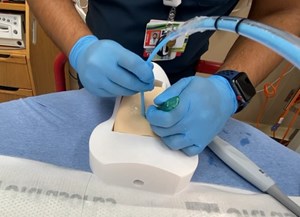
Lessons Learned from a 20 Years Running Research POCUS Symposium
Elizabeth Yetter, MD MHPE
Turandot Saul, MD, FACEP
Mount Sinai Morningside-West
The Emergency Ultrasound Division of Mount Sinai Morningside West, formerly known as St. Luke’s-Roosevelt, held its 20th Annual Regional Ultrasound Symposium titled “The Next Big Thing in Emergency Ultrasound” on Wednesday, April 26 in Manhattan, NY. Dr. Lawrence Haines from Maimonides Medical Center was the keynote speaker, discussing the trajectory of point of care ultrasound (POCUS) and its current crossroads with artificial intelligence (AI). He was followed by speakers giving lectures in the popular Pecha Kucha format: Dr. Michael Halperin from Jacobi Medical Center discussed the pericapsular nerve group block (PENG), Dr. Ee Tay from NYU advocated for a broader scope of pediatric POCUS, Dr. Roberto Ochoa from Mount Sinai Morningside’s cardiology department discussed transesophageal echocardiogram (TEE) and Dr. Colin Pesyna from The Mount Sinai Hospital’s critical care department bridged the clinical use and utility of TEE in the emergency department itself. This was followed by a moderated research forum that included five oral presentations and 36 poster presentations on a variety of ultrasound topics by residents, fellows and medical students from the tri-state area.
This year was our return to hosting a live event after three years on Zoom in accordance with group meeting restrictions due to the COVID-19 pandemic. There was a robust turn-out, with seven residencies in attendance and over 200 participants from New York, Connecticut, and New Jersey. The conference has grown and evolved over time, much like POCUS itself, with novel applications such as nerve blocks, TEE, and now AI. Dr. Elizabeth Yetter joined the Symposium Planning Committee in 2020 and along with her team, has brought in leaders in Emergency Ultrasound to give impactful, practice changing lectures that give the participants ways they can use ultrasound at the bedside tomorrow to take better and safer care of their patients. The introduction of the Pecha Kucha-style presentations have given junior and senior faculty alike an opportunity to shine on a focused high-yield topic. Dr. Turandot Saul continues to lead the research forum portion of the event, showcasing the top five highest scoring submissions as oral presentations with our largest number of poster presentations to date. The research forum has continued to highlight and disseminate the latest in POCUS research and allowed for junior researchers to obtain feedback on design and research methodology from experts in the field.
It has been fascinating watching our community take what was once novel, such as lung ultrasound, evolve into the examination of pulmonary windows for B-lines, air bronchograms, and absent lung sliding in resuscitation patients being incorporated into routine practice. This has only been accelerated by the COVID-19 pandemic. Nerve blocks are emerging, with protocols for new indications being introduced to provide non-narcotic pain relief into our emergency departments as well as for use in austere settings. Where AI will take us remains to be seen, but skilled, knowledgeable physicians to interpret and troubleshoot what AI can produce may lead to a major paradigm shift in the way we care for patients.
So how do we keep people interested and coming back for more education after 20 years of POCUS? How do we find new areas to explore? Early adopters and our residents’ and fellows’ research keep us moving forward and introduce us to new applications and protocols. Our research forum exhibits a wide range of research submissions, including those in the planning, patient enrollment or data analysis phases because it gives the medical students, residents, and fellows the opportunity to discuss their ideas and receive feedback from a panel of POCUS experts from a variety of institutions and geographical areas. With a year-long fellowship, many fellows’ work continues on after their graduation and we have seen studies resubmitted with completed data sets and interesting results. It is a pleasure to see how our community’s knowledge grows longitudinally over time. We plan to continue providing these opportunities to come together and discuss the future of our field, allowing young researchers to describe their new ideas in an accepting, nurturing environment for another 20 years.
Lessons Learned
- Give new voices a chance. We have had some great speakers over the years and recently, at the suggestion of some of our veteran speakers, we’ve shifted gears and sought out both senior and junior faculty who aren’t on the routine lecture circuit to breathe new life and ideas into our symposium.
- Quick, concise presentations grab participants’ attention and are a digestible length for adult learners. The introduction of the Pecha Kucha format over these past two years has proven to be a popular choice. Pecha Kucha-style is a deck of 20 slides with 20 seconds allotted per slide, (not including introduction and references). The slides progress automatically and require the speaker to have a well-rehearsed, dynamic talk.
- Expand research presentation opportunities. Keeping our residents and fellows engaged is critical to developing new ideas and points-of-view. Giving the junior members of our teams the opportunity to present allow for important skill building such as creating an effective poster and verbal presentation may spark an interest in a future researcher.



